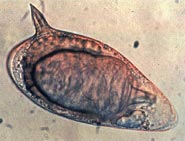
Photo from wikipedia
Fasciola hepatica and F. gigantica are ruminant liver flukes that are found worldwide. They can occur sympatrically and hybridize, consequently producing an intermediate form (Fasciola sp.), especially in Africa and… Click to show full abstract
Fasciola hepatica and F. gigantica are ruminant liver flukes that are found worldwide. They can occur sympatrically and hybridize, consequently producing an intermediate form (Fasciola sp.), especially in Africa and Asia. The bridge intron (TkBridgeInt) and intron 4 of domain 2 (TkD2Int4) of the taurocyamine kinase gene were cloned and sequenced from 14 F. hepatica, 18 F. gigantica, and 12 Fasciola sp. These intron regions could be used to differentiate F. hepatica from F. gigantica and revealed genetic hybridization and DNA recombination between F. hepatica and F. gigantica in Fasciola sp. from Japan and Bangladesh. Two specimens of F. hepatica from Ecuador revealed cryptic diversity. A combination of three haplotypes observed in a Fasciola sp. specimen from Japan suggested triploidy. Thus, the intron region of the taurocyamine kinase gene is a potential marker for detecting the hybrid status of the Fasciola flukes.
Journal Title: Molecular and biochemical parasitology
Year Published: 2018
Link to full text (if available)
Share on Social Media: Sign Up to like & get
recommendations!